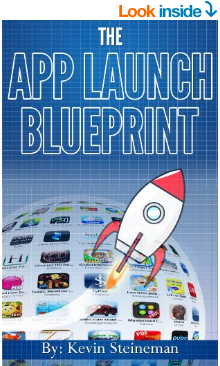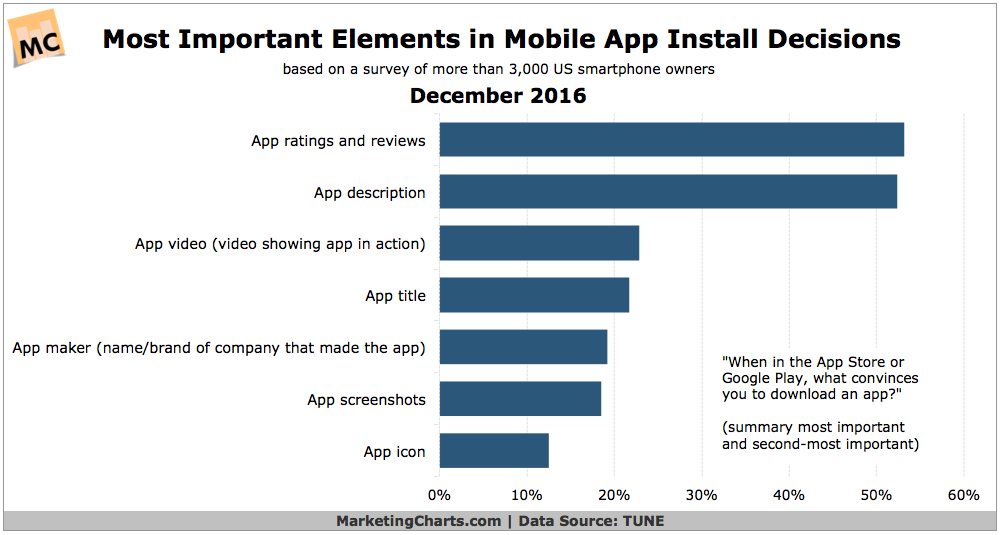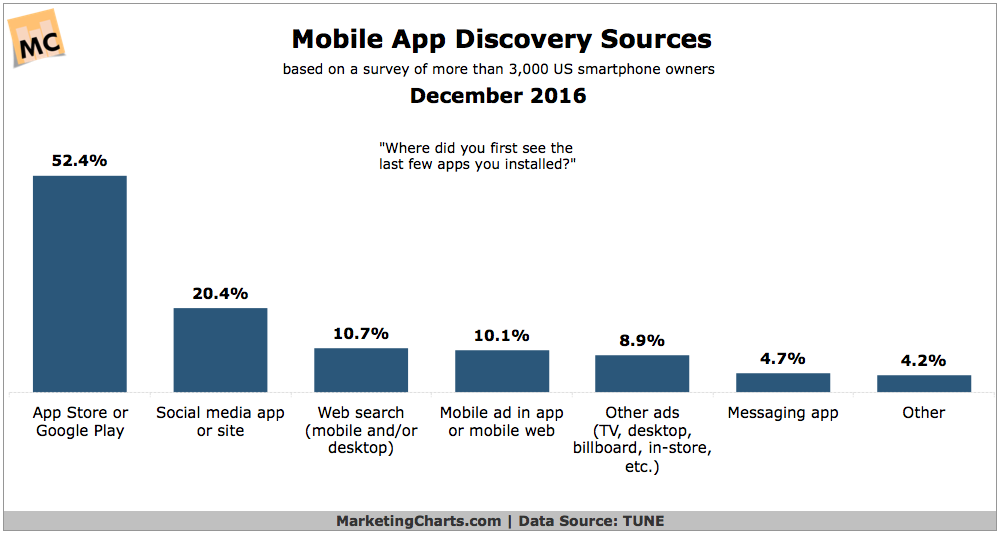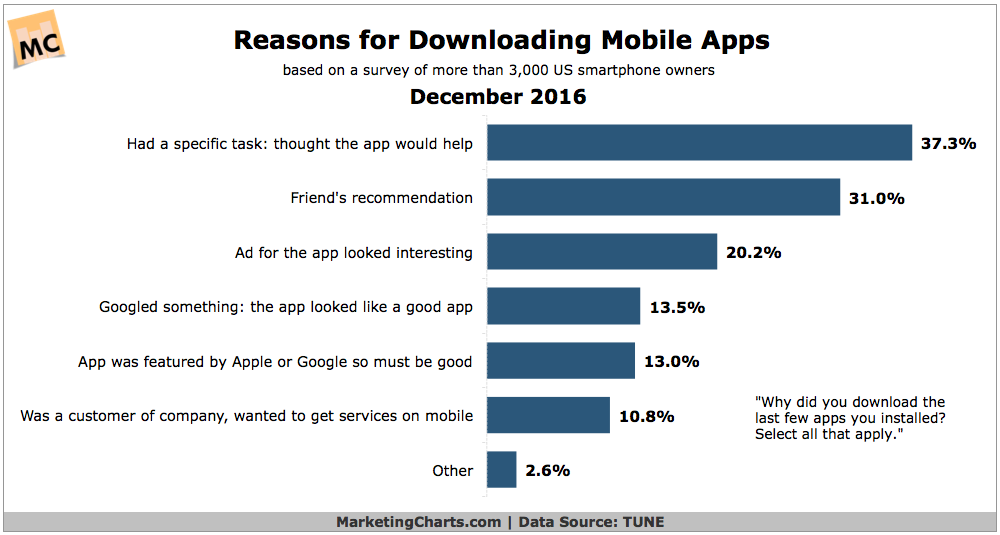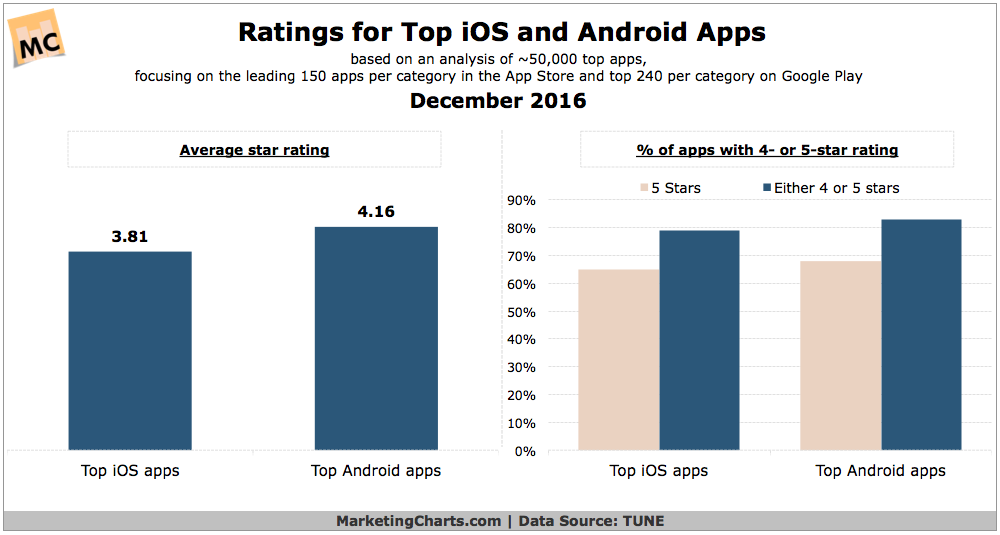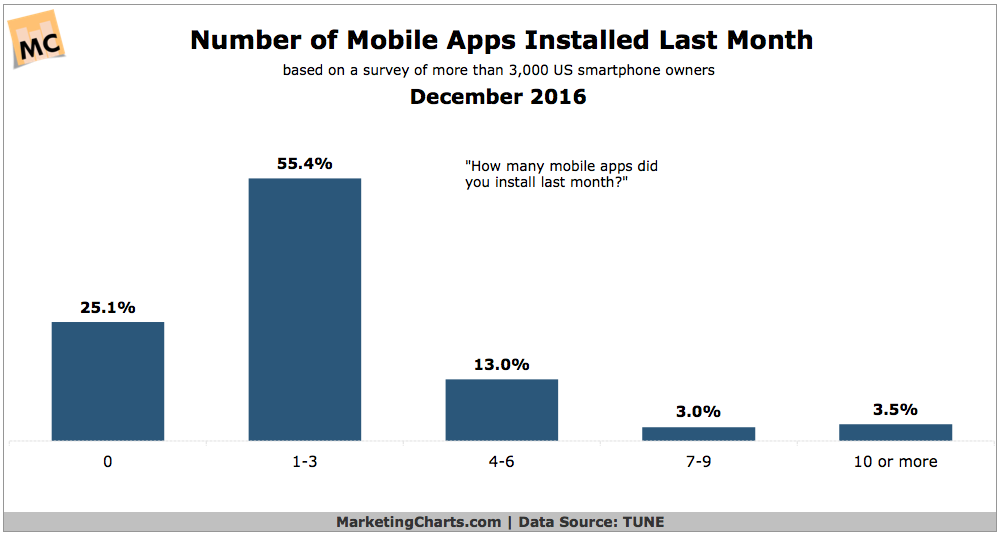5 Data Points to Point Your App Marketing in the right direction for 2017
App Marketing in 2017
It’s not every-day I decide to spend some time to express my thoughts on where things are headed in the app economy, or what people should be doing to really capitalize on all the hard work they’ve put into their products. But, then again – it’s not every-day a whole set of data points comes into my inbox (thanks Tune) that is compelling enough for me to consolidate them and put them into a piece with actionable insights.
So here we are. Below you’re going to find 5 data points with my take on them, the only hope I have as a result of you reading this article is that you can: drive more downloads, increase retention, and optimize your monetization plan to come out on top.
Let’s jump into it.
As we can observe above: Downloads(like purchases) still largely are determined by our peers opinions of products (the consensus). In this case, Your App. Chances are if you don’t have ANY reviews, or poor reviews, I would wager that your app is not performing very well in neither downloads or retention. I mean, how could it be? If it were a quality product people would be expressing such. Now, now, I know what you’re thinking – “Kevin, what about competitor apps/products/companies who deliberately leave fake negative reviews to hurt the name of your product/brand?” (AKA smear campaigns)
Well, my answer is this: how have other businesses grown in spite of these types of challenges? Think of restaurants & other businesses who have to deal with the same thing on Yelp. Think of media companies who have to deal with negative backlash across social media if they make the mistake of trying to be clever and instead come across offensive to the point where it goes globally viral. THINK OF APPLE, who is the biggest case and point of having to deal with Samsung’s constant and relentless smear campaigns but yet, still manage to come out ahead in the market.
The truth is, while these negative reviews (fake or not) may hurt the image of your product/company temporarily, there is something you can do about it. I was recently talking with someone from a pretty cool music company who are working on a new social music app that reminded me of another app I used to be pretty fond of called TurnTable.fm (RIP). What I remembered from our conversation was the proactive, accountable, determined attitude he had to improve upon what users were saying they wanted. And that’s exactly what you should do too.
Let’s face it. If you’re not willing to make an app that people find valuable enough to hang onto (on their phones), or continue improving until it is perceived as valuable, then you’re probably in the wrong business. With technology, guidelines, platforms, API’s and SDK’s constantly evolving you have to be on top of things. If you’re not, or don’t care to be – then again, you’re probably in the wrong business. There are services out there that allow you to manage/respond your reviews that come into your apps, and reach out to people to resolve bad reviews.
Tech is without a doubt one of the fastest changing industries in existence. It’s extremely competitive, but can also be extremely rewarding if you’re willing to work hard, change (for the better) as things evolve, and maintain an unquenchable thirst for making something people will appreciate.
To bring things full circle, do you think Apple would have $256-billion cash in the bank if they were deterred by what their competitors (and there have been many as they’ve entered different stages of business/hardware/software) did to try and prevent them from reaching the goals they had? I don’t think so. And just so you know, their free cash accounts for more than the other 2-10 companies COMBINED in the top-10 tech companies globally.
So create a product people love, and they will either choose to express what they love about it or not, in the end things will work themselves out and you will know if what you’re doing is right or not.
To briefly touch on the other stats above, sure – descriptions matter especially for proper ASO (as do: tags, categories, titles, images, videos and a few other things) but usually if a user has found you (most likely through the App Store or Google Play, depending) their decision will be largely influenced by what others have thought. It’s human nature.
Regarding App Videos, I believe they’re definitely a great way to showcase what your app can do and ideally show how to use your app so when users decide to download they already know exactly how to use it.
App Title: While I can see why this is considered almost equally important to videos, App Titles are really something that should be taken into consideration for both the purposes of passively influencing people to download BUT ALSO because it matters for ASO (App Store Optimization).
App Maker: This is typically not as important in a users eyes as the text is quite small and often over-looked in the moment someone is considering to download.
App Screenshots: While considered to be less important than who makes the app, I would say that App Screenshots are in-fact more important because they depict to your prospective users how the app will function without them having to download it. ‘App Maker’ just tells them who made it, and unless you’re a VERY WELL KNOWN company like: Apple, Facebook, Spotify, Google, Twitter, MobileMinute, etc. Then it doesn’t matter.
App Icon: I would say the importance for an App icon is having something that is both: eye-catching, fits into current design trends, but is also iconic for what your app is capable of doing. Of course the latter can be difficult to achieve, but certainly not impossible.
Let’s carry on..
As we can see above: With over 52% of of installs coming from directly within the App Ecosystem, it pays to have your App Store Optimization on point. Other popular forms of app discovery include: Social, Web/Mobile search, and native ads.
As seen above: It is evident that the majority of users are looking for an app that can solve a specific problem. One problem I often see with developers UI/UX’s is them having too many features and having such a unique UI/UX that its lost the intuitiveness that a user has gained by interacting with different apps thousands of times.
The thing is, once consumer behavior for app users has been adopted in mass if you digress from the traditional UX they’re accustomed to, something will feel off. This may be because you’re either trying to be too innovative, or not innovative enough to have the features they’re used to seeing. Think: swipe right, scroll down to refresh, two-taps to share, etc.
Some of the features mentioned above have become especially popular and also feel like second nature across every app, where if an app DOESN’T have the same features it will not feel right, and in the end hurt retention and increase churn. When it comes to friends recommendation for apps this can be thought of in a similar light as the recommendation for anything. People recommend things that are of good quality, or of good service (unless of course, you’re a disingenuous A-hole who is getting a commission from whatever it is you’re recommending and trying to shuffle people towards it solely for that purpose).
I’d like to think most people aren’t, however. To sum it up, if you focus on creating the best product possible some people WILL recognize it, most won’t – but some will, and those are the ones in the long-run who may help you reach your ambitions sooner than you thought possible. As for the other 20-13% of people who download for the following reasons..
Ad for the app looked interesting: This is a direct result of having a strong marketing campaign to showcase how your app can be the solution the prospective user has been looking for. Remember, they’re looking for specific solutions so the app who is best able to demonstrate that will win.
Google Something: app looked like a good app: Again, this is a user searching for a solution to a problem they have and self-identifying that your app is the solution to that problem.
App was featured by Google or Apple, so it must be good: Who better to recommend you than Google or Apple? Everything discussed above about getting a recommendation from a friend is even more prevalent if that recommendation is in the form of being featured by Apple or Google.
As seen above: Most iOS apps fall around a 3.8 Star Rating whereas most Android apps fall around a 4.1 Star Rating. The difference could be attributed to iOS Users expecting more from apps with all the “Top Apps” within the app ecosystem, however the real take away should be that you need to strive to do better than the “average rating”. 65% Top iOS Apps come in with 5-stars, whereas nearly 80% come in with either 4 or 5 stars. Your goal should be right there in the middle: 4.5. If you’re ambitious go for 5, I encourage you to – but understand not everyone is going to love your product, and sometimes the reasons are simply unreasonable. Top Android apps come in with nearly 65% at 5 stars and 82% at either 4 or 5 stars. Again, aim for the moon and at least you’ll land among the stars (4 or 5 at least).
As seen above: Long gone are the days when people are installing apps in droves, open to discovering new apps to try on their phones, or simply having a lot of apps because.
December alone represents the busiest week for the app ecosystem because of the tens of millions of new devices people typically receive over the holidays. With that being said, you can imagine every-other month users are not nearly as interested in getting new apps. If they do, it’s likely a game that will be gone, or no longer being used within the first 30-90 days.
Indeed we have entered a consolidation stage for the app economy so if you’re developing, creating, or making a new app and you intend to succeed you truly need to ask yourself these things:
- How is this app different than what people are using for the same or similar purpose?
- Does My App really have a strong value proposition that will earn the screen space on a users device?
- Is my app something people will feel a need to use, or form a habit around?
There are a number of other questions you should ask, but that’s a good place to start. I hope this article has been helpful in knowing what to focus on for the year ahead to reach the goals you have in mind. If you need any help along the way, you know where to find me.


